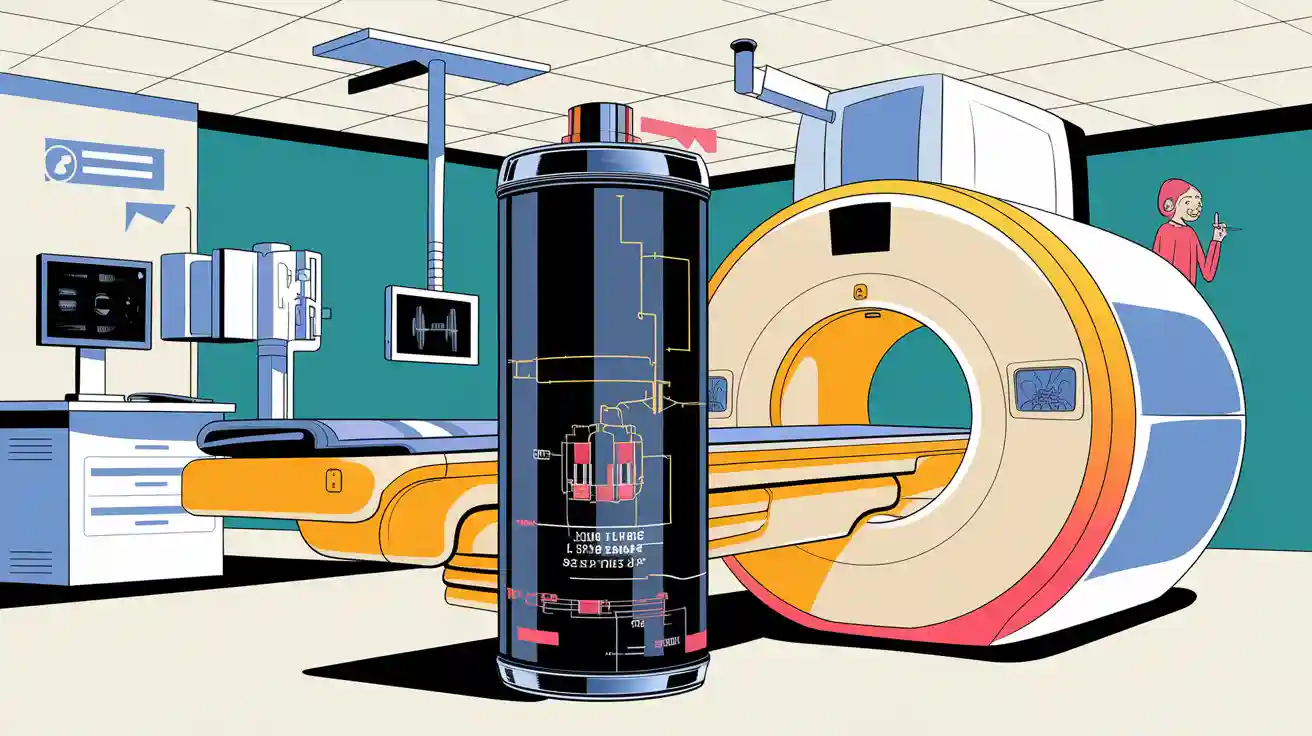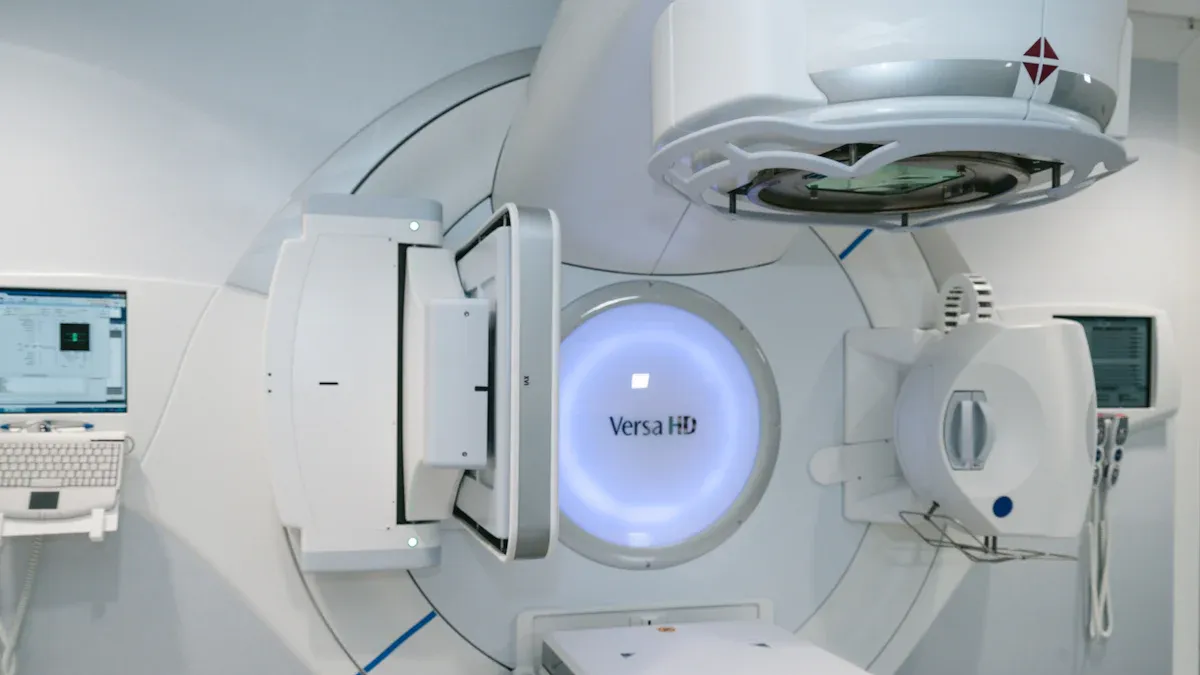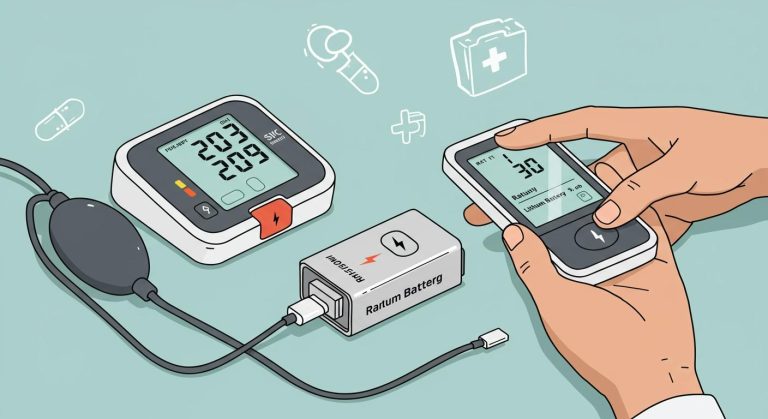
Lithium batteries are vital components in medical imaging equipment. They provide consistent power to devices like MRI machines and portable ultrasound systems, ensuring uninterrupted operation during critical diagnostics. Reliable power prevents malfunctions that could compromise diagnostic accuracy. For robotic-assisted surgeries and AI-powered monitoring, stable energy delivery maintains precision and safeguards critical healthcare workflows from disruptions.
Key Takeaways
Lithium batteries give steady power to medical imaging tools. This helps them work without stopping and gives correct results.
Picking the right lithium battery, like lithium-ion or lithium polymer, improves how the device works for its specific job.
Safety features, like stopping overcharging and smart battery systems, are key to keeping medical devices dependable.
Part 1: Types of Lithium Batteries for Medical Imaging Equipment

1.1 Lithium-ion Batteries
Lithium-ion batteries dominate the market for medical device batteries due to their exceptional energy density and long cycle life. These batteries can deliver up to 270 Wh/kg, making them ideal for powering high-performance medical imaging equipment like portable ultrasound machines. Their ability to maintain over 800 charge-discharge cycles at 80% capacity ensures reliability and longevity. Additionally, lithium-ion batteries have a self-discharge rate significantly lower than alternatives like NiMH or lead-acid batteries, reducing maintenance needs.
As of 2025, lithium-ion batteries powered 70% of newly manufactured medical devices, reflecting their widespread adoption. Their lightweight and compact design further enhance their suitability for portable and handheld imaging devices. These features make lithium-ion batteries a cornerstone of modern medical imaging technology.
1.2 Lithium Polymer Batteries
Lithium polymer (LiPo) batteries offer a unique advantage with their flexible form factor. Their lightweight and slim design make them an excellent choice for compact medical imaging devices. Despite their smaller size, they deliver high energy density, ensuring sufficient power for extended usage.
LiPo batteries are particularly favored in applications where weight and space are critical, such as handheld imaging tools. Their versatility allows manufacturers to design medical devices with innovative shapes and sizes without compromising performance. However, since LiPo batteries are tailor-made, the required order quantities are significantly higher.
1.3 Lithium Iron Phosphate Batteries
Lithium iron phosphate (LiFePO4) batteries stand out for their safety and durability. These batteries resist overheating and fires, making them the safest option among lithium batteries for medical devices. They also have a significantly longer lifespan, often lasting up to 10 years or more.
LiFePO4 batteries are eco-friendly, containing no hazardous materials, and require no maintenance. Their superior charge and discharge characteristics make them reliable for high-demand applications, such as backup power for stationary imaging equipment. Additionally, they weigh up to 70% less than traditional lead-acid batteries, reducing the overall weight of medical devices.
Category | Types of Lithium Batteries |
|---|---|
Types | Lithium-ion, Lithium iron phosphate, Lithium polymer |
Discharge Performance | Conventional discharge, High-rate, Low-temperature |
Shape | Cylindrical, Prismatic, Polymer |
Each type of lithium battery for medical imaging equipment offers distinct advantages, allowing you to choose the best option based on your specific needs.
Part 2: Advantages of Lithium Batteries for Medical Devices
2.1 High Energy Density and Long Usage Times
Lithium batteries for medical devices offer unmatched energy density, enabling extended usage times for critical equipment. You benefit from batteries that deliver energy densities ranging from 100 to 270 Wh/kg, ensuring reliable power for portable and stationary medical devices. This high energy density supports long service life, reducing the need for frequent replacements and minimizing downtime during operations.
For example, lithium-ion batteries, a popular choice for medical device batteries, provide up to 270 Wh/kg and a cycle life of 1,000 to 2,000 cycles. These metrics highlight their ability to sustain performance over time, making them ideal for devices requiring consistent power, such as imaging systems and wearable monitors. By choosing batteries with superior energy density and longevity, you ensure uninterrupted functionality and enhanced patient care.
2.2 Reliability and Consistent Performance
Medical device batteries must deliver consistent performance to maintain the accuracy and reliability of imaging equipment. Lithium batteries excel in this regard, offering stable energy output even under high-demand conditions. Their advanced battery management systems prevent overcharging and overheating, ensuring safe and reliable operation.
You can trust lithium-ion batteries to power devices like portable ultrasound machines and mobile X-ray systems without interruptions. Their long service life and ability to withstand multiple charge-discharge cycles make them indispensable for medical applications. Enhanced safety features further reduce risks, especially in implantable devices, where reliability is paramount.
2.3 Lightweight and Compact Design
Lithium batteries for medical devices are designed to be lightweight and compact, making them ideal for portable and handheld equipment. You’ll find that lithium-polymer batteries, for instance, are up to 20% lighter and thinner than lithium-ion batteries of the same capacity. This reduction in size and weight enhances the compatibility of batteries with modern medical devices, allowing manufacturers to create innovative designs without sacrificing performance.
These features make lithium batteries indispensable for applications where portability and ease of use are critical, such as handheld imaging tools and wearable monitors.
2.4 Fast Charging Capabilities
Fast charging capabilities are essential for ensuring medical devices remain ready for use at all times. Lithium batteries excel in this area, offering fast-charging options that reduce downtime and improve operational efficiency. You can rely on these batteries to power devices like chest compression systems and portable ultrasound machines, which require rapid recharging to maintain functionality during emergencies.
However, fast charging must be managed carefully to prevent issues like lithium-ion accumulation or graphite structure degradation. Advanced battery management systems mitigate these risks, ensuring safe and efficient charging. This feature is particularly beneficial for energy storage systems in healthcare settings, where readiness and reliability are critical.
Part 3: Safety Considerations and Certifications
3.1 Compliance with Medical Standards
Ensuring compliance with medical standards is critical when selecting a medical device battery. Lithium-ion batteries used in medical devices must meet stringent safety and performance requirements. Manufacturers like Large Power adhere to quality assurance guidelines during the development, design, and production stages to ensure safety and environmental friendliness. Incoming materials undergo rigorous testing, and every assembled battery pack is subjected to 100% outgoing control to maintain high manufacturing standards.
Certifications such as CB, IEC 62133, UL2054, UL/CSA62133 validate the safety and essential performance of lithium-ion batteries used in medical devices. These regulatory standards ensure that the batteries meet global safety benchmarks, making them reliable for critical healthcare applications. Large Power’s manufacturing center, operating in an ISO Class 7 cleanroom with strict temperature and humidity controls, complies with the stringent standards for medical devices.
3.2 Battery Management Systems
Battery management systems play a pivotal role in maintaining the safety and performance of lithium-ion batteries. These systems regulate charging and discharging cycles, preventing issues like overcharging, deep discharging or thermal runaway. They also monitor the battery’s health, ensuring consistent performance over its lifespan.
For medical devices, a reliable BMS ensures uninterrupted operation, which is crucial for diagnostic accuracy. Whether you’re using portable ultrasound machines or mobile X-ray systems, a well-designed BMS enhances the safety and longevity of your medical device batteries.
Part 4: Performance and Compatibility Factors
4.1 Energy Efficiency and Power Output
Lithium batteries for medical devices deliver exceptional energy efficiency and robust power output, making them indispensable for critical applications. Their ability to maintain consistent power delivery ensures uninterrupted operation of imaging systems, even during high-demand scenarios. For example, portable medical device batteries charge faster than older technologies, improving equipment availability during emergencies.
4.2 Temperature Tolerance and Stability
Medical devices often operate in environments with fluctuating temperatures. Lithium batteries excel in temperature tolerance, maintaining stability across a wide range of conditions. Whether used in wearable medical devices or imaging systems, these batteries resist performance degradation caused by extreme heat or cold.
Lithium-ion batteries incorporate advanced thermal management systems to prevent overheating, ensuring safe operation during emergencies. This feature is particularly beneficial for wireless medical device batteries, which require reliable performance in diverse settings. By choosing lithium batteries, you ensure compatibility with demanding medical applications.
4.3 Longevity and Maintenance
The longevity of lithium batteries reduces the need for frequent replacements, saving time and costs for healthcare facilities. Medical device batteries, including those used in continuous glucose monitors, offer extended service life with minimal maintenance requirements. Their ability to withstand thousands of charge-discharge cycles ensures consistent performance over time.
Lithium-ion batteries also feature self-monitoring systems that detect potential issues early, enhancing reliability. These systems optimize battery health, reducing downtime and ensuring compatibility with medical devices that demand uninterrupted operation.
4.4 Custom Battery Pack Options
Custom battery pack options allow manufacturers to tailor lithium batteries to specific medical device requirements. Whether you need portable medical device batteries for handheld imaging tools or high-capacity solutions for stationary equipment, customization ensures optimal performance and compatibility.
Applications of lithium-ion batteries extend to devices like continuous glucose monitors and wearable medical devices, where compact designs and lightweight features are critical. Customization also enhances safety, integrating advanced features like overcharge protection and thermal management. By opting for tailored solutions, you maximize the efficiency and reliability of your medical device batteries.
Part 5: Applications of Lithium Batteries in Medical Imaging Devices

5.1 Portable Ultrasound Machines
Lithium batteries for medical devices play a crucial role in powering portable ultrasound machines. These machines rely on lightweight and compact batteries to ensure mobility and ease of use during diagnostic procedures. You benefit from the enhanced reliability and performance that lithium-ion batteries provide, especially in emergency scenarios where quick deployment is essential.
Ultrasound technology improves the safety and efficiency of lithium batteries in these devices. It detects potential issues like thermal runaway and adjusts battery behavior to prevent failures. This proactive approach enhances safety features, ensuring uninterrupted operation during critical diagnostics. Portable ultrasound machines equipped with lithium batteries offer cost-efficient testing methods that improve accuracy and patient care.
5.2 Mobile X-Ray Systems
Mobile X-ray systems depend on medical device batteries to deliver consistent power for imaging procedures. Lithium batteries excel in this application due to their high energy density and fast charging capabilities. You can rely on these batteries to maintain performance during extended usage, even in demanding healthcare environments.
Lithium-ion batteries provide the stability required for mobile X-ray systems, ensuring diagnostic and monitoring devices operate without interruptions. Their advanced safety considerations, including overcharge protection, make them ideal for use in high-demand medical devices. These systems benefit from the lightweight design of lithium batteries, which enhances portability and ease of transport.
5.3 Handheld Imaging Devices
Handheld imaging devices require compact and lightweight medical device batteries to support their innovative designs. Lithium polymer batteries are particularly suited for these applications, offering flexibility in shape and size without compromising performance. You gain the advantage of extended usage times and reliable power delivery, essential for accurate diagnostics.
These devices often operate in diverse environments, making temperature tolerance a critical factor. Lithium batteries for medical devices maintain stability across varying conditions, ensuring consistent performance. Their fast charging capabilities further enhance usability, allowing healthcare professionals to focus on patient care without worrying about battery downtime.
5.4 Backup Power for Stationary Equipment
Stationary imaging equipment, such as MRI machines, relies on backup power systems to ensure uninterrupted operation during power outages. Lithium iron phosphate batteries stand out in this application due to their durability and safety features. You benefit from their long lifespan and eco-friendly design, which reduces maintenance requirements and environmental impact.
These batteries provide reliable backup power, ensuring stationary equipment continues functioning during emergencies. Their advanced certifications, including regulatory certifications like IEC 62133, validate their safety and performance. By choosing lithium batteries for backup systems, you enhance the reliability of critical imaging equipment and safeguard patient diagnostics.
Part 6: How to Choose the Right Medical Device Battery
6.1 Assessing Power and Capacity Needs
Selecting the right medical device battery begins with evaluating your equipment’s power and capacity requirements. You need to determine the energy density and cycle life that align with your device’s operational demands. For portable and implantable devices, lithium-ion batteries offer energy densities up to 270 Wh/kg, ensuring extended usage times and reliable performance.
Consider the voltage and current requirements of your medical equipment. Stable voltage outputs prevent malfunctions and ensure consistent operation. Many lithium batteries retain 80% of their original capacity after 800 charge-discharge cycles, making them ideal for devices requiring longevity and reliability.
Tip: Regularly test batteries in life-critical equipment to ensure they meet performance standards. Consult healthcare providers for advice on battery maintenance and replacement schedules.
6.2 Ensuring Performance and Compatibility
Compatibility plays a crucial role in battery selection. You must ensure the battery integrates seamlessly with your medical device’s design and operational parameters. Lithium batteries excel in performance and compatibility, offering stable power output and quick charging capabilities.
Note: Follow the manufacturer’s guidelines on battery lifespan and replacement to maintain optimal performance and compatibility.
6.3 Evaluating Safety Features
Safety is paramount when choosing a medical device battery. Look for batteries with advanced safety mechanisms, such as overcharge and overheat protection. Battery management systems (BMS) regulate charging and discharging cycles, preventing thermal runaway and ensuring safe operation.
Medical-grade lithium batteries are used in over 90% of FDA-approved devices, highlighting their reliability and safety. Certifications like IEC 62133, UL/CSA62133 and UL2054 validate their compliance with stringent safety standards. By prioritizing safety features, you minimize risks and enhance patient care.
6.4 Partnering with Trusted Suppliers
Collaborating with a reliable supplier ensures you receive high-quality batteries tailored to your medical device needs. Trusted suppliers like Large Power offer over 20 years of expertise in medical battery solutions. Delivering over 2,000 medical rated battery projects, Large Power provides custom battery packs designed for specific applications, ensuring optimal compatibility and performance.
Callout: For customized lithium battery solutions, contact Large Power to explore tailored options for your medical imaging equipment.
Lithium batteries are indispensable in medical devices, ensuring reliable power for critical imaging equipment. Their lightweight design, high energy density, and fast charging capabilities enhance portability and performance. The table below highlights their key benefits:
Benefit | Description |
|---|---|
Portability | Lightweight design allows for easy transport of medical devices without adding extra weight. |
Reliability | Long life cycle reduces the need for frequent replacements, crucial for patient care. |
Energy Density | High power output in a compact size enhances device performance. |
Temperature Sensitivity | Functions effectively across various temperatures, ensuring reliability in diverse conditions. |
Fast Charging | Fast charging time (1-2 hours) is essential for emergency medical devices. |
Safety | Prevents overcharging and discharging, ensuring safety for both devices and patients. |
Looking ahead, advancements in lithium battery technology will transform medical applications. Key trends include:
A projected surge in the lithium-ion battery market for medical devices by 2033.
Increasing demand for portable medical devices and specialized battery designs.
A focus on eco-friendly materials and sustainable manufacturing processes.
These innovations promise safer, more efficient solutions for healthcare.
FAQ
What makes lithium batteries ideal for medical imaging equipment?
Lithium batteries offer high energy density, lightweight design, and long life. These features ensure reliable power for portable and stationary medical imaging devices.
How can you extend the lifespan of lithium batteries in medical devices?
Follow manufacturer guidelines, avoid overcharging, and store batteries in a cool, dry place. Regular maintenance ensures optimal performance and longevity.
Tip: Use battery management systems to monitor health and prevent overcharging.
Are lithium batteries safe for medical applications?
Yes, lithium batteries meet stringent safety standards like IEC62133, UL2054 and UL/CSA62133. Features like overcharge protection and thermal management ensure safe operation in critical medical environments.
Note: Always choose certified batteries for medical devices to minimize risks.






